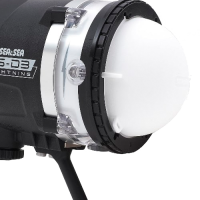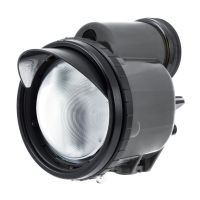Sea & Sea YS-D3 Strobe Mk II
Sea & Sea YS-D3 Strobe - NEW Mk II Model - 2022
IN STOCK NOW
Sea&Sea has now updated its flagship YS-D3 strobe to the YS-D3MKII.
The new updates enhance TTL shooting and third-party optical converter compatibility while still retaining all the great features, such as a 33 Guide Number, wide Beam Angle and broad flash distribution of the original D3
The new MKII model will be a “running change” update, that is, the product number (#03123), will remain the same.
Features of the YS-D3MKII model
Newly developed software enables compatibility with existing and previous Sea&Sea optical converters. TTL shooting with the YS-D3MKII can now be enjoyed using the YS-D2 position on the S&S optical converter.
A newly designed circuit improves the accuracy of TTL light intensity with compact cameras and also provides greater compatibility with third-party Optical TTL converters.
The design of the light intensity adjustment dial and mode switch has been revised for better useability in all diving environments.
The difference can be easily recognized from the outside by the MKII label on the side of the unit and the new control knobs on the rear.
High-Performance Strobe
The new Sea & Sea D3 has been newly designed circuitry and the light-emitting unit produces a powerful guide number of 33. In addition, a high precision aspherical optical toroidal lens has been fitted over the two flash tubes to disperse an even light from the centre to the edge. The strobe`s beam angle will increase to 110°by attaching the standard accessories Diffuser. When the optional Dome diffuser is attached, the beam angle will increase to as wide as 150(TBD)
In order to avoid misunderstanding, the YS-D3 guide number (GN) and the beam angle are based on measurements taken on land (not underwater)
Some competitors will often state a GN measured on land and the beam angle in water, for example, a GN 33 and beam angle of 110 degrees. However, this GN 33 value is based on a beam angle of 60~70 degrees. The beam angle may be expanded in water by a dome effect, however, the GN in water is significantly lower than the value measured on land.
Note: A land-based strobe that uses the same four AA batteries as the YS-D3 may provide a notation that the GN is 60, but these measurements are taken under the condition that the focal length is equivalent to 200 mm (= beam angle 12 °). When the beam angle becomes narrower, the brightness of the illuminated area increases due to the light-collecting effect.
Superior consecutive firing capability to capture those critical moments.
The YS-D3 utilizes larger capacity condensers compared with those used on competing strobes. In addition, the D3 is also equipped with a newly designed charging circuit. As a result, the YS-D3 will fire at GN16 continuously without any interval time. Even when the strobe is fired at GN22, the strobe will fire again within a mere 0.8 seconds.
When the YS-D3 is fired at Guide Number over 22, two-stage ready-to-fire signals will be issued. For instance, after the strobe fires at full power of GN33, the strobe will inform you both visually and audibly when the condenser is charged to fire at GN22. Then, when the condenser is charged enough to fire at GN33, another different signal will be issued. This design allows you to release more shutters in scenes where you want to shoot as many pictures as possible, maximizing shooting intervals between scenes
Target light with increased power
incorporating a uniquely designed aluminium heat diffuser, the target light is now powerful enough to be used as a dive light.(About 4 times brighter than YS-D2)
Various accessories available for all underwater imaging experiences
・Dome diffuser (optional accessory)
Increases beam angle to 150(TBD). Essential accessory when the fisheye lens is used or soft light is required.
+ Guide number will drop to -(TBD)EV when it is fitted.
・Snoot (optional accessory)
A strobe adaptor which narrows the beam angle to be directed at a target point. The diameter of the opening 25mm. Designed with an internal prism which aligns target light`s light axis and strobe`s light axis to the centre.
・Slave prism (optional accessory)
Optical guiding device to fire the strobe when a fibre-optic cable is not used. This device is for manual use only. The device is effective if multiple strobes are used in a fixed position. However, the flash may not fire depending on the position of where multiple flashes are occurring in relation to that of the master flash.
Excellent visibility
Backlight panel that is effective when shooting in dark environments The indicator colour on the back of the YS-D3 changes each time the position of the mode switch is changed. Blue (in DS-TTLII mode), light blue (in slave TTL mode), orange (in manual mode with pre-flash), and green (in manual mode without pre-flash) The positioning of the operating system is obvious during night diving.
* The colour in DS-TTLII mode has been changed from the YS-D2 to match the colour with the optical converter.
Connection method with arm that can be selected according to preference
YS-D3 comes with a straight type ball base.
Optional YS base and new Diagonal ball base can be installed depending on the application.
YS base (common to YS-D1 / D2 / D3)
Traditional YS base. Easy vertical swing.
Diagonal ball base (only for YS-D3)
A ball base inclined at 35 ° compared to the straight type. This makes it easier to lower the strobe backwards, making it suitable for shooting when using a dome port. Also, when a Synchro Cord N is installed, interference between the cord and the ball clamp is minimized.
Specifications
- Guide Number (ISO 100/m) (land)] : 33, 28 (with Diffuser attached)
- Beam Angle: 105°x80° (without Diffuser), 110°x100°(with Diffuser)
- Batteries: 4xAA A: 6V Ni-MH: 4.8V
- Number of Flashes *1: A: 140 Ni-MH: 220
- Recycle time (full) *2: A: 3.5 sec. Ni-MH: 1.7 sec.
- Color temperature: 5800K
- Color temperature w/diffuser: 5500K
- Depth rating: 100m / 330ft
- Dimensions (WxHxD): 92x111x147mm / 3.6 x 4.4 x 5.8 inches (excluding ball base)
- Weight: 610g / 21.5oz (w/o batteries) (excluding YS-base)
- Underwater weight: Approx.+40g / 1.4oz (incl. batteries)
- Exposure control: DS-TTL II, Slave TTL, Light level control dial (GN): 1 / 1.4 / 2 / 2.8 /4 / 5.6 /8 / 11 / 16 / 22 / 33 (11 steps)
- DS-TTL II function
- Slave function
- Auto power OFF function 30min
- Sync cord: 5-pin Sync cord/N, Fiber-Optic Cable
- Over-pressure relief valve
- LED target light (output is adjustable in 2 steps)
- Audible charge signal
- *1 Number of flashes and recycle time depends on the battery brand, temperature and frequency of use.
- *2 Number of flashes and recycle time of Ni-MH batteries were tested on 2500 mAh batteries.
What's in the box
- Sea & Sea YS-D3 Mk II Strobe
- Ball Mount Adaptor
- 100° Diffuser















